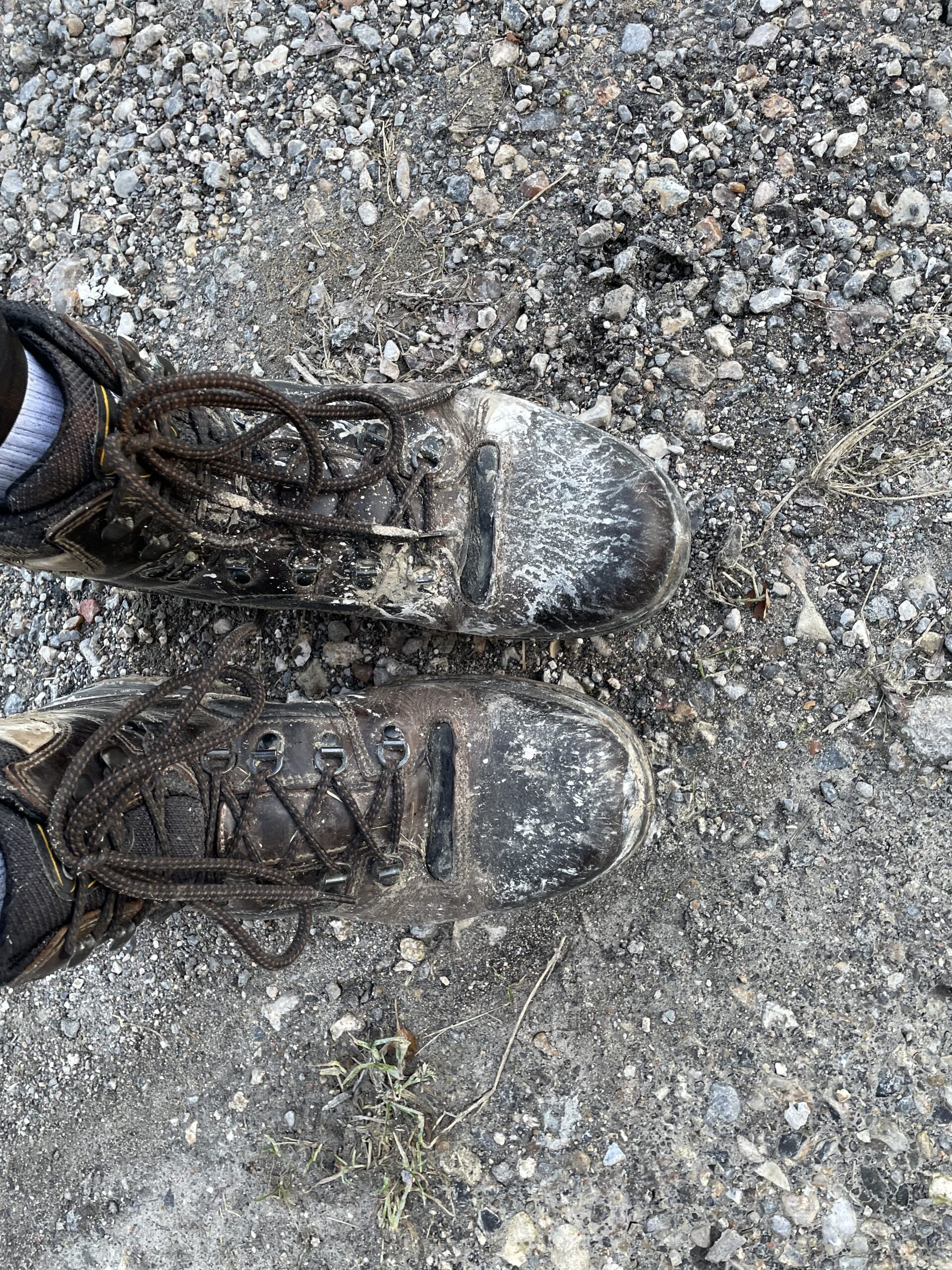Ridgeway Walk: 12-13 October 2024
I’d wanted to walk the Ridgeway ever since reading about it in Robert Macfarlane’s Old Ways. It’s a massive miss from my walking repertoire: not only is it the oldest road in Britain, (a venerable 5,000 years), but it’s also packed with history including a good chunk related to the Anglo-Saxon period which I got pretty into at uni.
So, time to redress this and bite a chunk of it. I’d settled on the stretch from Foxhill to Goring with the weekend I’d set aside and set off from Paddington bright breezy on Saturday morning. This meant I arrived early in Swindon with just over an hour to kill before the first bus to Foxhill. I was so grateful for this time though, Swindon is stunning! (Ha)

I got the hell out of Swindon on the 48 bus to Foxhill before jumping out at the Burj, my starting point. Alas it was shut, but from appearances I think the Burj is kind of like the United Nations, but in restaurant form.


Time to begin! Briefly stopping to admire my first Ridgeway ‘Plaswood’ sign: an environmentally friendly and maintenance free material. Actually quite smart given the number of battered wooden signs I’ve seen over the years.

I bucked off the trail early and went to see some strip lynchets and ancient medieval field systems. Apparently these formed when they ploughed on slopes for so long the gravity made the loose earth fall down and form ‘steps’. After seeing a range I can believe that for the little lynchets. But I saw some huge ones too that looked like intentionally earthworked steps. Must have been pretty backbreaking to form if so…


Oh, and I had to be naughty and find gaps in fences to see them all.

But I also saw some deer being super cute!
From there it was back to the Ridgeway before my next detour to Alfred’s Castle. Quick summary before you get too excited:
-Not actually a castle (and has never been),
-In reality it actually has nothing to do with King Alfred (the Victorians made up that King Alfred used the site to rally his troops against the Danes in the Battle of Ashdown so that they could sell trinkets to tourists)
-It’s really an Iron Age hill fort dating back to 6th century BCE that was later (1st century) the site of a Romano-British farmhouse.
-Now it’s just some earthworks with loads of nettles inside.
Here’s a wonderfully 1950s primer on the site. (I couldn’t find any traces of the building or any sarsen stones.)
The 5km round trip from the Ridgeway was beautiful though, and the sun was shining!


Then it was on to Waylands Smithy, which is a properly cool place. It dates from 3600 BC when a timber chambered oval barrow was built to bury 14 people. 150 years later it got an upgrade in the form of a stone hammered long barrow.
When the Saxons found it (4,000 or so years later) they decided that the magical/God Smith Weyland from Norse folk tales lived there. In the stories Weyland was captured by a cruel king who cut his hamstrings, stole the ring his wife gave him and took his magical sword, all the while forcing Weyland to make him cool smith stuff.
Weyland got a bit narked about this. He killed the king’s sons, turned their skulls into goblets and their eyes into jewels, which he presented to the king, before fashioning a magical flying cloak and escaping. Pretty wild.
The Saxons used to leave unshod animals or broken tools outside the barrow overnight, along with coins, so Weyland would fix them.
Despite all this, it’s actually a beautifully serene place! And it’s pretty powerful to be able to interact with something this steeped in history.

Fun fact: Weyland gets a name check in Beowulf, when Beowulf is fighting the dragon in the third part of the story he says:
“Onsend Higeláce, gif mec hild nime,
beaduscrúda betst, Þæt míne bréost wereð,
hrægla sélest, Þæt is Hraédlan láf,
Wélandes geweorc. Gaéð á wyrd swá hío scel.”
Roughly translated as:
Send to Hygelac, if me battle takes,
battle-shirt best, that my breast protects,
garment finest, that is Hrethel’s legacy,
Wayland’s work. Fate goes ever as it must.
The dragon then kills him (and vice versa) and the story ends with the enemy hordes assembling on the hills to attack his tribe now that Beowulf is gone. Turns out fates a bit of a bitch sometimes.
Here’s a great article on Weyland if you want to know more.
Then it was on to Uffington, with more earthworks, another dragon slaying, and a massive horse.
Here’s Uffington Castle. As you can see it’s another exciting circle-mound. This one’s from the 8th or 7th century BCE and continued to be occupied throughout the Iron Age. It used to have ramparts, sarsen stone walls, and relics of occupation. It’s lost all these fun bits now though.

But dragons are fun, and Dragon Hill just behind it is where George slayed his dragon. And if you’re sceptical about whether that actually happened then you can tell it definitely did because on the top of the hill (which was artificially flattened at some point) there’s an empty white chalk patch where nothing grows because this is where the dragon blood spilt.

One final sight here. A huge, 360 feet long and 130 feet wide, white chalk horse carved into the side of the hill. However, what I found even more surprising than it’s weirdness is how difficult it is to find despite its size. It’s been carved in a minimalist, abstract style best viewed from drone/helicopter (or if you’re a God, which I think was the intention vs anticipating drone cams). I spent ages trying to find it, imagining that it would be super prominent. Instead it looks like this- almost impossible to take a photograph of.


This was the first ever English white horse carving. No-one’s quite sure why this was made at some point between 1380 and 550 bc. Maybe something to do with the Celtic goddess Epona? Maybe it’s actually a dragon? Maybe a tribal symbol? (Similar figures appeared on coins too). It initially seemed odd to me that something this significant could be constructed without a record of why. But then I learned about the behaviour of locals between the 17th and 19th centuries. They held “scouring festivals” every seven years, which included not only clearing vegetation and renewing the faded top layer of chalk, but also climbing greasy poles, rolling wheels of cheese down a hill, pipe-smoking marathons, sledding down the hill on horse jawbones and other batshit crazy English activities. Sometimes I guess humans are just beautifully odd.
Oh, and to cap it all off, Channel 4 used it to advertise the 4th season of big brother. Which really pissed the locals off!

As a final bit of inspiring weirdness, check out David Bedford’s Song of the White Horse (1978), set for ensemble and children’s choir and commissioned for the BBC. The choir had to inhale helium balloons to sing the “stratospherically high notes” of the climax, accompanied by aerial footage of the horse animated to show it rearing up from the ground.
Back to the Ridgeway before the next deviation, to have a go on the Blowing Stone, a sarsen stone that Alfred ‘apparently’ (I’m growing sceptical of all these Alfred stories) used to summon his troops to fight the Danes). More excitingly for me, it’s featured in William Horwood’s Duncton Chronicles novels, which I bloody loved as a kid!
I didn’t really nail getting a sound out of it. But in my defence I think it’s been quite eroded, and it was full of water and snails.
Then on to the final stretch to my campsite, stopping briefly to check out Segsbury Castle, before quickly realising it was basically just another big circular mound with nothing to see inside it. I was a bit earthworked out by this point.



A beautiful moment with the low sun framed by the trail behind me spaghettifying my shadow, with the moon already out.
Then, finally, arriving at Court Hill Centre just in time to pitch my tent before dark, and make some Michelin starred food before settling in.


37.8km on day 1, which was a bit more than I was expecting. Got a bit carried away with exploring, and quite a chunk of that was tramping around looking for a big white horse!


I had a terrible night’s sleep. It was freezing, I should have brought my warmer sleeping bag, and my inflatable sleeping bag sprung several leaks due to age. So I woke up full of joy and with my body and feet raring to go for day two…
Kidding, I got up seriously considering heading to the nearest station and getting home to a warm, soft bed! But after porridge, a change of socks, and some ridiculously strong coffee I was good to go.
Day 2 was far sparser on historic interest, so I told myself that this was all about ‘Type 2 fun’. A term I stole from my old rugby coach meaning not the kind of fun that’s fun at the time (Type 1) but the kind of fun that isn’t fun at the time but becomes rewarding/fun after it’s done. That bit of mental gymnastics got me moving.
There were a couple of interesting things to see, including the Wantage monument that Lady Wantage build to commemorate her husband, Baron Wantage, who seems to have invented the hipster beard.


The quote from Psalm 121 ‘I will lift up mine eyes unto the hills from whence cometh my help’ was quite moving given her context of mourning her husband, and the placement of the monument.

I stopped for lunch at Scutchamer Knob, the site where King Edwin killed King Cwichelm in 593 (Edwin said he’d convert to Christianity, but only if he beat Cwichelm, which seems a fair enough deal). Don’t feel too sorry for Cwichelm, he’d tried to send an assassin to kill Edwin earlier, so wasn’t exactly squeaky clean. (All the Anglo-Saxon rulers were pretty brutal to be honest.) There’s a burial mound here (more earthworks) and for quite a while people thought Cwichelm was buried here, but excavations have turned up nothing.


From here on in it was a case of enjoying the rolling scenery and making peace with the pain in my feet through to the end. Other notable things that happened:
-I tried to make friends with a horse and got electrified by a fence in the process.
-I got asked by a woman if I was ok when I was having a rest stop (I clearly looked a bit broken)
-I saw loads of these rocks with black shiny sections covered by white silty rock. Google Lens hasn’t definitively answered what they are, so if anyone knows please tell me!


And then, as darkness fell, I made it to Goring station for the journey home. A comfy seat in a warm train carriage has never felt so good!
27km for day 2. Less than day, but it felt like more!
